Abstract
The study was conducted in order to evaluate the motor level of male handball players for determining the level of their physical training, which could be decisive for the analysis and the subsequent development of the training process. The participants in this assessment were a group of male handball players, junior II level (15-16 years old), members of five athletic clubs in the country, and a sample group made up of the members of junior national team for the same age category, from the National Olympic Excellence Centre in Sighișoara. The testing, as an assessment instrument used in this study, consisted of 6 trials set by the aforementioned centre and used in the periodic testing of the teams that are part of the centre, and the application of the value scale of result quantification corresponding to these trials. The results indicated the following conclusion in terms of the level of physical training: a rather low level of physical training for the members of four clubs participating in the survey and a good level for the members of the fifth club. The most important conclusion drawn subsequent to conducting this analysis is that most athletic clubs do not test their athletes periodically, a measure that was a prerequisite years ago in order for the athletes to be allowed to play, which may set certain limits to the development of a proper training process.
Keywords: Motor potentialtestingdeterminationphysical training
Introduction
Physical training in handball creates the basis on which the future sports performance can be built and at the same time the basis for approaching the other components of the training process targeting all athletes, regardless of their age and athletic competence, but conditioned by good physical health (Mihăilă, 2006a).
Being a fundamental element of the general training process, indispensable to the other elements involved, physical training is a condition for the achievement of results and the development of future players. Physical training means the continuous optimisation of motor ability, as well as the development of morphological and functional parameters of the body, according to handball requirements. It represents a major factor for the progress of performance in the current stage, holding 25-30% of the total training time in the case of junior players.
Physical training has an impact on the entire training process, influencing the performance of the athletes during training sessions as well as during competitions (Simion, Mihăilă, Stănculescu, 2011).
Epuran (2005) tells that evaluation in professional sports is the process of making judgments on the measurement results, judgments that take into account certain criteria and represent the purpose of the measurement.
In the field of sports the guiding marks in knowing the subjects are their performances, their efficiency, the results of the evaluation having the purpose of determining the actions to be taken by those engaged in this system (Tătaru, 2011).
The measurement techniques used for evaluation in sports games, handball in our case, are as follows:
The control test – is the simplest method of evaluating the performance capacity, which helps check the athlete’s genetic potential or that achieved during the training process;
The control valuation – is represented by pre-set standard scales according to which athletes are ranked. It is closely connected with the control test, which is usually constant, while the control valuation changes from a training level to another;
The test – is a standard evaluation procedure with a clearly set content (test type and number), application criteria (the same for all tested athletes) and evaluation scales (set according to age and training level);
The set of tests – consists of a series of tests chosen to assess the performance capacity of the players and team. It is a testing method recommended for participants in sports games.
Mihăilă (2006b) considers that the purpose of control tests and control valuations is:
To check the training level of all athletes;
To earn the right to participate in official competitions;
To promote the multi-talented elements to superior categories.
Principalul obiectiv al aplicării testelor este obținerea de informații exacte asupra unor caracteristici studiate în vederea formulării unui prognostic privind dirijarea științifică a procesului de instruire, sau evaluarea gradului de eficiență a unor mijloace utilizate (Niculescu, Mateescu, Crețu, Trăilă, 2006).
Problem Statement
The study was conducted over a period of three months in the training centres of the following teams: Sighișoara – “Radu Voina” Sports Hall; Făgăraș – “Doamna Stanca” High School Gym; Iași – Sports High School Gym; Odorheiu Secuiesc – Sports Hall; Sibiu – “Transilvania” Sports Hall.
The study included 87 athletes from the above sports clubs: Sighișoara – 14 athletes from one club and 16 from another, Făgăraș – 16 athletes, Odorheiu Secuiesc – 14 athletes, Iași – 12 athletes, Sibiu – 15 athletes.
The objectives of the study were:
Taking the required control tests;
Determining the physical training level of the players through a comparative analysis between the results obtained in the testing and the standards from the evaluation grid used in this study.
Research Questions
Does the periodic evaluation still represent a valid method of determining the physical potential of young handball players?
Purpose of the Study
The evaluation of motor skills in young handball players, with the purpose of determining as exactly as possible their physical training level, a process that can represent a helping instrument designed to permanently improve the training process.
Research Methods
-
the theoretical analysis and the generalisation of data extracted from the literature;
-
the pedagogical observation method;
-
the pedagogical observational experiment method;
-
the physical training testing method;
-
the statistical-mathematical data processing method;
-
the diagram and the tabular method.
Findings
The analysis was made on a statistical-mathematical basis for each test and each of the 6 clubs analysed in this study:
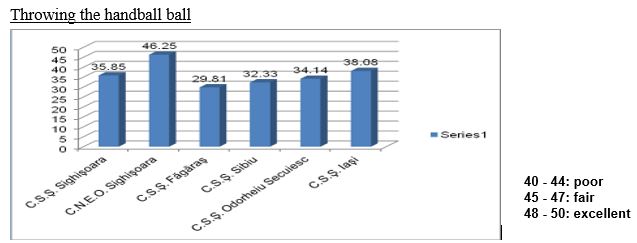
Starting from these figures, the standard exception has been settled for each team, and it is very small for the athletes from CNOE Sighișoara (S = ±1.09 m) and small for the other clubs: CSS Sighişoara (S = ±3.78 m), CSS Făgăraş (S = ±3.35 m), CSS Sibiu (S = ±4.05 m), CSS Iaşi (S = ±2.11 m), CSS Odorheiu Secuiesc (S = ±4.08 m). Also, the calculated variable rate indicates a great homogeneity in the case of CNOE Sighişoara (Cv = 2.36%), CSS Iaşi (Cv = 5.54%), and a medium homogeneity for CSS Sighişoara (Cv = 10.05%), CSS Făgăraş (Cv = 11.16%), CSS Sibiu (Cv = 12.65%), CSS Odorheiu Secuiesc (Cv= 11.95 %).
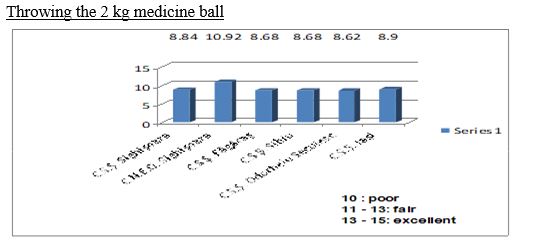
The resulted standard exceptions are: ±0.10 m (the smallest) for CNOE Sighişoara; ±1 m (the biggest) for CSS Sibiu; ±0.14 m for CSS Sighişoara, ±0.20 m for CSS Făgăraş, ±0.25 m for CSS Odorheiu Secuiesc, ±0.46 m for CSS Iaşi. The calculated variables indicate high homogeneity rates for CSS Sighişoara (1.58%), CNOE Sighişoara (0.91%), CSS Făgăraş (2.30%), CSS Odorheiu Secuiesc (2.90%), CSS Iaşi (5.17%) and medium rates for CSS Sibiu (11.52%).
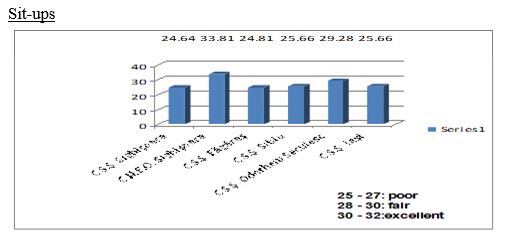
The standard exceptions are: ±1.26 reps (the smallest) for CSS Făgăraş, ±2.70 reps for CNOE Sighişoara, ±2.40 reps for CSS Sibiu, ±1.98 reps for CSS Sighişoara, ±3.10 reps (the biggest) for CSS Odorheiu Secuiesc, ±1.86 reps for CSS Iaşi. The calculated variables indicate high homogeneity rates for the five teams: CSS Sibiu = 9.37%, CSS Sighişoara = 8.03%, CNOE Sighişoara = 8.18%, CSS Făgăraş = 5.11%, CSS Iaşi = 7.25% and medium rates for CSS Odorheiu Secuiesc = 10.59%.
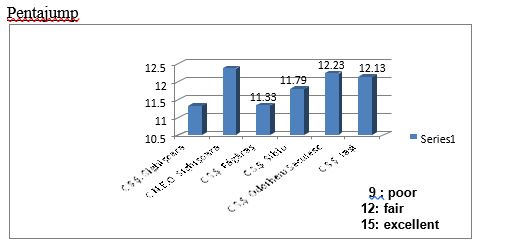
The calculated standard exceptions are: ±0.80 m for CSS Sibiu, ±1.33 m (the biggest) for CSS Sighişoara, ±0.63 m (the smallest) for CNOE Sighişoara, ±0.63 m for CSS Făgăraş, ±1.30 m for CSS Odorheiu Secuiesc, ±0.95 m for CSS Iaşi. The homogeneity rate is high for CSS Sibiu = 6.80%, CSS Sighişoara = 8.84%, CNOE Sighişoara = 5.11%, CSS Făgăraş = 5.58%, CSS Iaşi = 7.84% and medium for CSS Odorheiu Secuiesc = 10.63%.
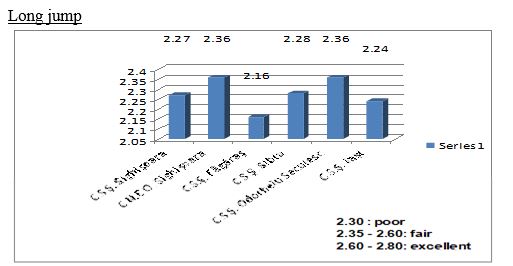
The following standard exceptions resulted: CSS Sibiu ±0.26 m, CSS Sighişoara ±0.55 m (the biggest), CNOE Sighişoara ±0.44 m, CSS Făgăraş ±0 m (the smallest), CSS Odorheiu Secuiesc ±0.83 m (the biggest), CSS Iaşi ±0.52 m. The homogeneity rate is medium for CSS Sibiu (11.72%) and CNOE Sighişoara (18.46%), low for CSS Sighişoara (24.22%), CSS Odorheiu Secuiesc (35.17%), CSS Iaşi (23.22%) and high for CSS Făgăraş (0%).
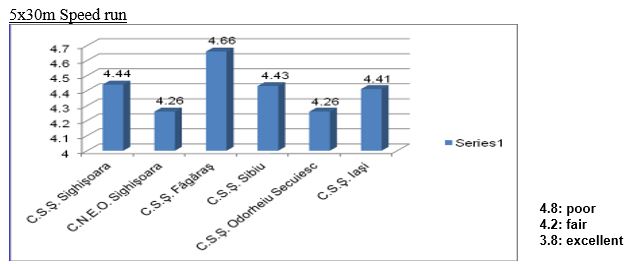
The resulted standard exceptions are: CSS Sibiu ±0.15 sec., CSS Sighişoara ±0.30 sec. (the biggest), CNOE Sighişoara ±0.13 sec., CSS Făgăraş ±0.08 sec. (the smallest), CSS Odorheiu Secuiesc ±0.28 sec., CSS Iaşi ±0.10 sec. The two statistical mathematics indicators led to the following variables: CSS Sibiu = 3.46% (high homogeneity), CSS Sighişoara = 6.87% (high homogeneity), CNOE Sighişoara = 3.09% (high homogeneity), CSS Făgăraş = 1.71% (high homogeneity), CSS Odorheiu Secuiesc = 6.58% (high homogeneity), CSS Iaşi = 2.27% (high homogeneity).
Conclusion
-
The first acknowledgement that has come out of this study is that, at the level of sports clubs that train young handball players, the Romanian Handball Federation no longer requires players to pass certain control tests that were mandatory several years ago in order for the players to be allowed to play for the category they belonged to. As a consequence, very few clubs (of the 11 or 12 sports clubs with which we got in touch, only 5 were sent back a positive response), through coaches who prepare players of all categories, still use control tests as a method to periodically determine the level of training of the athletes they are working with;
-
Related to this subject, we must mention that, although there are individuals possessing a good motor level, the lack of special training designed for such tests caused these athletes to achieve poor results in the control tests, compared to what they might have achieved if they had been specially trained in that area. The most important aspect of the aforementioned is the problem of not being familiar with the execution technique (the most eloquent examples were those of the long jump and the pentajump);
-
As a result of the analysis and according to the evaluation scale presented above, we can assert that the potential level of the tested athletes is: rather low for four of the evaluated clubs, CSS SIBIU, CSS FĂGĂRAŞ, CSS SIGHIŞOARA, CSS IAŞI (four out of six tests scored LOW); good when we refer to CSS ODORHEIU SECUIESC (four tests scored GOOD); more than good for the Sighișoara National Olympic Excellence Centre (four GOOD scores and two VERY GOOD scores);
-
The fact that four out of six teams have achieved low motor potential standards confirms once again the first conclusion underlined above, according to which the lack of certain official evaluations monitored by the professional federation causes a negligent approach on the part of coaches and athletes, those who are concerned with this major aspect – the motor potential;
-
This study may be the answer to question number 3, in the sense that, by using the periodic testing based on control tests consistently standardised by field specialists, we can, whenever we want, reach to a level of valid appreciation of the physical training standards for the athletes we are working with;
-
An important conclusion, in our opinion, is that having such an evaluation as a starting point, it is much more efficient for coaches to project their future approach on the planning and content of the training process, especially of the physical training part.
References
- Epuran, M. (2005). Metodologia cercetării activităţilor corporale. Bucureşti: FEST.
- Mihăilă, I. (2006a). Handbal - Optimizarea pregătirii fizice specifice la echipele de juniori. Craiova: Universitaria.
- Mihăilă, I. (2006b). Evaluarea în selecţia şi pregătirea handbaliştilor de performanţă. Craiova: Universitaria.
- Niculescu, M., Mateescu, A., Crețu, M., Trăilă, H. (2006). Bazele științifice și aplicative ale pregătirii musculare. Craiova: Universitaria.
- Simion, Ghe., Mihăilă, I., Stănculescu, G. (2011). Antrenament sportiv – concept sistemic. Constanța: Ovidius University Press.
- Tătaru, C. (2011). Măsurarea și evaluarea în educație fizică și sport. Sibiu: Alma Mater.
Copyright information

This work is licensed under a Creative Commons Attribution-NonCommercial-NoDerivatives 4.0 International License.
About this article
Publication Date
05 March 2018
Article Doi
eBook ISBN
978-1-80296-035-8
Publisher
Future Academy
Volume
36
Print ISBN (optional)
-
Edition Number
1st Edition
Pages
1-484
Subjects
Sports, sport science, physical education, health psychology
Cite this article as:
Stoian, I. (2018). Periodic Testing – A Prerequisite for an Exact Determination of Physical Training Standards. In V. Grigore, M. Stanescu, & M. Paunescu (Eds.), Physical Education, Sport and Kinetotherapy - ICPESK 2017, vol 36. European Proceedings of Social and Behavioural Sciences (pp. 318-324). Future Academy. https://doi.org/10.15405/epsbs.2018.03.42

